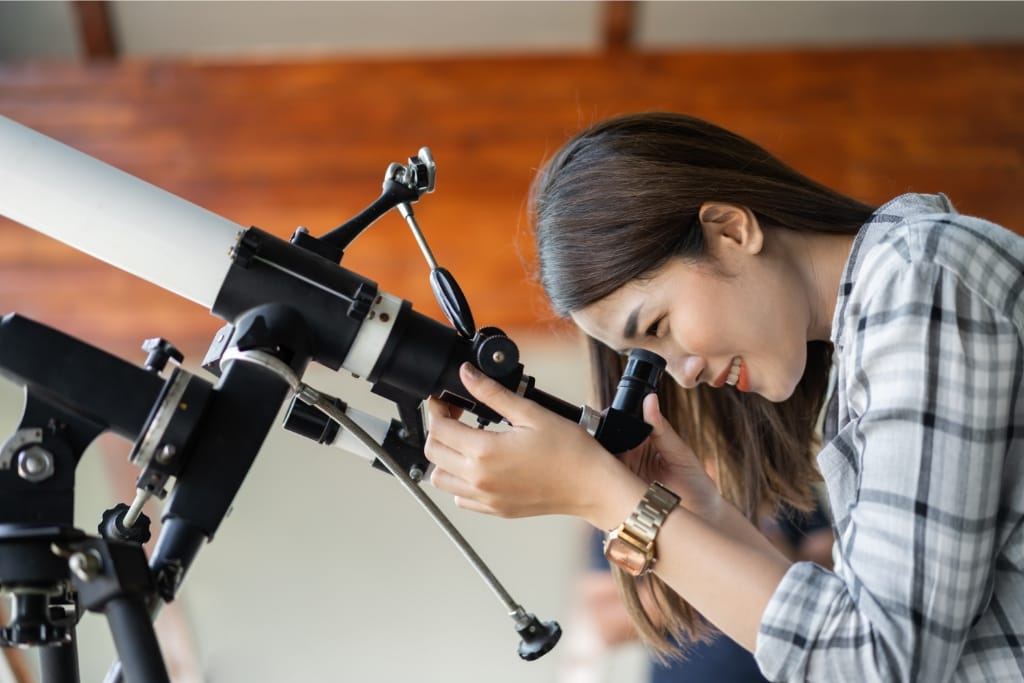Stargazing has always captivated the human imagination, inspiring us to wonder about the mysteries of the universe and our place within it.
For anyone who's felt the pull of the night sky—the mesmerizing glow of constellations, the dazzling beauty of planets, or the fleeting streak of a shooting star—the idea of owning a telescope can open the door to an entirely new level of exploration.
Whether you dream of observing the rings of Saturn, the craters of the Moon, or the distant brilliance of far-off galaxies, buying your first telescope is an exciting step in beginning your astronomical adventure.
However, with so many options and technical specifications to consider, it's easy to feel overwhelmed by the process.
That's where this guide comes in. Here, we've compiled 12 essential tips to help you confidently choose your first telescope, ensuring that your stargazing experience is as rewarding and awe-inspiring as the cosmos itself.
1)) Determine Your Budget
Deciding how much you are willing to spend is a crucial first step when venturing into the world of astronomy.
Telescopes vary widely in price, with options ranging from affordable beginner models to high-end, advanced equipment.
By setting a clear financial limit, you can focus your search on devices that match your level of interest and experience without feeling overwhelmed by the sheer number of choices.
It’s important to remember that beyond the telescope itself, there may be other expenses to consider, such as accessories, maintenance, and storage.
Having a realistic budget in mind helps you make a practical decision while ensuring that your introduction to stargazing starts on the right track and fits seamlessly into your circumstances.
2)) Choose Telescope Type
Selecting the right telescope type is crucial for ensuring an enjoyable stargazing experience, especially as a newcomer to the hobby.
There are three main types of telescopes to consider—refractors, reflectors, and compound telescopes—each tailored to different observing preferences and budgets.
Refractor telescopes are low-maintenance and ideal for viewing planets and the moon with sharp clarity.
Reflector telescopes, on the other hand, are better suited for observing faint deep-sky objects like nebulas and galaxies due to their larger apertures.
Compound telescopes combine key features of both and are highly versatile, making them a flexible choice for those wanting to explore various celestial objects.
It's important to evaluate where and how you plan to use your telescope, as some models are more portable or better suited for specific locations.
Understanding these distinctions will empower you to choose the telescope that best aligns with your interests and aspirations in astronomy.
3)) Understand Aperture Size
The aperture size of a telescope is one of the most critical factors to consider when making your first purchase in the world of stargazing.
Aperture refers to the diameter of the primary lens or mirror in the telescope, and it directly influences how much light the instrument can gather.
A larger aperture allows you to see fainter objects and reveal greater detail in celestial bodies, making it an essential aspect of your decision-making process.
Beginners are often drawn to telescopes with smaller apertures due to their affordability and ease of handling, but it's important to weigh this against the types of objects you wish to observe.
Whether you're interested in exploring the surface features of the Moon, spotting distant planets, or observing deep-sky objects like galaxies and nebulae, the aperture size determines the clarity and amount of detail you will experience.
By understanding this concept, you can make a well-informed choice that aligns with your astronomical goals and ultimately elevates your viewing experience.
4)) Consider Portability
Portability is an important factor to keep in mind, especially if you intend to use it in various locations or away from light-polluted areas.
A compact and lightweight telescope can be much easier to transport, set up, and store, making the entire stargazing experience more convenient and enjoyable.
Heavy or bulky equipment can become a hassle to move and may discourage you from taking full advantage of the telescope’s capabilities.
By choosing a practical size and weight that suit your lifestyle, you ensure that your telescope remains a source of excitement and curiosity, rather than a cumbersome piece of equipment.
This consideration is particularly relevant for beginners, as it encourages more frequent use and helps to build confidence in exploring the night sky.
5)) Learn About Mounts
Understanding the importance of mounts is crucial for a smooth stargazing experience.
A stable and reliable mount ensures that your telescope remains steady, providing clear and consistent views of celestial objects.
There are two main types of mounts to consider: alt-azimuth and equatorial. An alt-azimuth mount is simpler to use and is ideal for beginners, as it moves in up-down and left-right motions, making navigation intuitive.
On the other hand, an equatorial mount is designed to follow the rotation of the Earth, which can help track objects over longer periods, especially during extended observation sessions or astrophotography.
Carefully choosing the right mount for your needs can significantly enhance your enjoyment of exploring the night sky and make the process far more rewarding.
6)) Check Included Accessories
It's important to pay attention to the included accessories, as they can make a big difference in your stargazing experience.
Items like a sturdy tripod, additional eyepieces, or a star map can greatly enhance your ability to locate and view celestial objects.
A finder scope, for example, is an essential tool that helps pinpoint specific stars or planets with ease.
Similarly, a good-quality diagonal mirror can improve the viewing angle, making long observation sessions much more comfortable.
Beginners should also consider whether the telescope comes with a protective carrying case, which is invaluable for safely transporting and storing the equipment.
Evaluating these extras ensures that your first telescope is well-equipped to meet your needs and provides a smoother, more enjoyable introduction to astronomy.
7)) Focus On Ease Of Use
Ease of use is a critical factor to consider when selecting your first telescope as a beginner.
To fully enjoy your stargazing experience, it is important to choose a telescope that is user-friendly and straightforward to set up.
Complicated designs or systems may create unnecessary frustration, especially for those who are new to astronomy.
Look for telescopes that have intuitive controls, clear instructions, and require minimal assembly, ensuring that your time is spent observing the wonders of the night sky rather than struggling with the equipment.
Features like a stable mount and simple alignment procedures can significantly enhance your experience, allowing you to focus on exploring celestial objects with confidence and ease.
By prioritizing simple operation, you can ensure that your telescope becomes a gateway to discovering the universe rather than a source of confusion.
8)) Research Reputable Brands
It is crucial to consider the reputation and reliability of the brand you choose.
Well-established brands are often known for their high-quality materials, precise engineering, and excellent customer support, all of which can greatly enhance your stargazing experience.
Reading reviews, seeking advice from astronomy communities, and exploring recommendations from experienced enthusiasts can help guide you toward trusted manufacturers.
Investing in a product from a reputable company not only ensures durability but also provides peace of mind, knowing that your telescope is designed to deliver clear and captivating views of the night sky for years to come.
9)) Account For Storage Space
Considering storage space is an important aspect when purchasing your first telescope.
Telescopes come in various sizes, and while larger models might offer enhanced viewing capabilities, they can also be cumbersome to store and transport.
If you have limited space at home, a more compact and portable model may be more practical. It's also worth thinking about where the telescope will be kept when not in use to protect it from dust, humidity, and accidental damage.
A sturdy case or designated storage area can help maintain its condition and ensure it's always ready for your next stargazing adventure.
Balancing size, functionality, and the available storage space will help you make a decision that best suits your needs.
10)) Read User Reviews
Reading user reviews is an invaluable step when choosing your first telescope, especially as a beginner.
These reviews can provide real-world insights into the performance and reliability of different models, giving you a clearer picture beyond the product descriptions.
Many experienced stargazers often share personal tips, discuss any challenges they encountered, and highlight features they found particularly useful.
This firsthand feedback can help you identify common issues or exceptional qualities, making it easier to decide which telescope aligns with your expectations and interests.
Take time to read reviews from various sources to get a balanced perspective before making your purchase.
11)) Explore Upgrade Potential
When selecting your first telescope, considering its capacity for future upgrades can be an essential aspect of your decision-making process.
Look for models that allow components such as eyepieces, mounts, or even software to be replaced or improved over time.
This ensures that your telescope can grow with you as your skills and interests expand, providing both longevity and value for your investment.
A telescope with customizable features not only enhances your viewing experience but also allows you to explore new techniques and celestial objects as you progress.
Starting with a model that offers this level of versatility can make the transition from beginner to more advanced stargazing seamless and enjoyable.
12)) Avoid Poor Quality Options
It’s essential to prioritize quality and durability to ensure a rewarding stargazing experience.
A well-constructed telescope made from reliable materials will provide sharper images and last longer, giving you greater value for your investment.
Poorly made devices may deliver blurry or distorted views, discouraging beginners from pursuing their interest in astronomy.
A well-designed telescope often includes user-friendly features, making it easier for new users to set up and operate.
Ensuring you research reputable brands, read reviews, and consult experienced enthusiasts can guide you toward making a choice that enhances your enjoyment of the night sky.
Conclusion
Purchasing your first telescope as a beginner is an exciting step into the fascinating world of astronomy, and with the right approach, it can be a highly rewarding experience.
By following these 12 key tips, you can ensure that your investment is both practical and suited to your needs.
Define your goals, set a realistic budget, and understand the types of telescopes available before making a decision.
Research is crucial—read reviews, seek advice, and prioritize quality over features that may not serve your interests as a newcomer.
Equally important is considering ease of use and portability, as these aspects can greatly impact your enjoyment and willingness to engage with the night sky regularly.
Learning to use your telescope and discovering the stars, planets, and beyond can become a lifelong passion, but it begins with making informed choices.
Don’t rush the process; take the time to educate yourself and explore your options.
Whether you are drawn to observing bright celestial objects like the Moon or seeking out deep-sky wonders, the right telescope can open up endless opportunities for exploration and awe.
Your first telescope isn’t just a tool—it’s the gateway to a greater understanding of the universe and your place within it.
With a bit of patience and curiosity, the beginner steps you take today will spark a love for astronomy that lasts a lifetime.
Download Our Free E-book!







